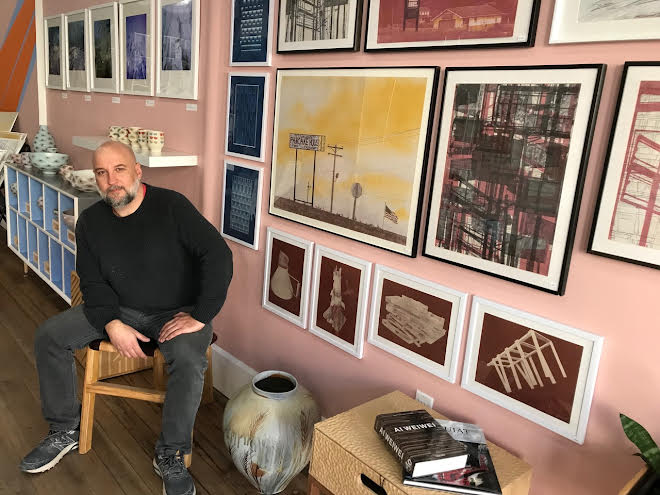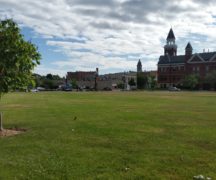By DAVID DUPONT
BG Independent News
Ceramics artist Andrew Gilliatt took over the space at 131 W. Wooster St. just before the pandemic set in.
Since then it has served as packing and shipping space as well as a studio for his woodworking and painting, and as a creative outlet – he painted murals on the walls. The window displaying his pottery served as a backdrop for “glamour” shots for high school seniors, he said.
The work in the windows – coffee cups, bowls and vases with geometric patterns of umbrellas, hot dogs, birds, and other pop culture imagery – teased art lovers about what was happening within. Occasionally Gilliatt would appear inside at work on the floor or the walls. He did open during the Black Swamp Arts Festival.
On Saturday, Nov. 13, what is now called Gallery 131, will open its doors for a Holiday Sale from 5 to 9 p.m.
Featured will be work by Little Bare Furniture, painter Kathleen Pahl, printmaker and photographer Ross Mazzupappa, and multidisciplinary artist Christina Humble.
Gilliatt said the idea for the show started with discussions with Ellen Fure Smith, of Little Bare, and her husband, Anthony Smith, who also teaches in the BGSU School of Art. “It was good timing because she always does a big open house around this time of year, but she’s got unvaccinated kiddos, so they didn’t want to do anything in their house.”
Gilliatt always wanted to do a sale during the holidays because for him and other makers it’s usually the best time for sales. He suggested: “Let’s do whatever you do over there here. So that’s kind of the idea for this weekend opening.”
Beyond Saturday’s open house, the gallery will be open Saturdays from 10 a.m. to 6 p.m. through Dec. 11.
Gilliatt described the gallery as a pop-up collective, with the artists taking home almost all the money from the work they sell in the gallery.
What form the venue takes beyond December is up in the air. “I don’t know what shape or form this space will take,” he said. “I don’t have a rigid idea of what form it will take. I just think there’s huge potential in bridging the gap between the university and the community.”
A lot of “amazing” artistic activity takes place on campus, not just art shows, but concerts and plays “ I don’t think that often translates downtown,” he said.
He’s open to whatever use creative types may want to use the gallery for. Maybe a jazz trio concert or a spoken word performance. “A lot of what might happen is going to be dictated by what the community wants.”
The former Dada gallery location proved valuable for Gilliatt when his studio on campus was shuttered because of COVID-19. It was the first time in 20 years that he was without a studio. But he used that time to paint the walls, including murals. He hauled in a free upright piano, and with the help of a pianist friend is working on tuning it.
An associate teaching professor, Gilliatt, 42, has been at BGSU for seven years.
He started out his studies in art at Virginia Tech as a graphic designer. Ceramics was a required course. “I immediately took to it because it was challenging ,” he said. “If it hadn’t been so challenging, I wouldn’t be so interested.”
He took several ceramics courses, but graduated as a graphic design major. He wanted nothing to do with graphic design. He didn’t want to spend his time working on a computer.
He took an internship at a Kansas City, Missouri ceramic workshop, and arrangement he called “work to play.”
“I remember being very scared,” Gilliatt said. “moving a 1,000 miles from home to do this thing I only have nine credits in, I didn’t know how to do anything other than move clay around .I didn’t know how to make clay, how to fire kilns. I knew I was young and if it didn’t work out, it didn’t work out, but I’d always regret it if I didn’t try.”
It worked out, and he went on to get his Master of Fine Arts from Louisiana State University. From there he got a fellowship at the Archie Bray Foundation in Montana.
That’s where he first met his future colleague John Balistreri, the head of ceramics at BGSU.
Over the years, his work has evolved. His graphic design training is evident in the patterns on his work. He relies on a computer for the design.
He doesn’t think his younger self would have acknowledged his current work as ceramics. He creates the initial shape and then makes a mold to replicate it. He’s interested in bright colors and pop imagery. “I think of it as a form of printmaking,” he said.
He tells students “to keep their eyes open.” What they think of as ceramics at that age is what they’ve been told is ceramics. In his case, “I was defining it on things that I saw. Then the work becomes a reaction to that you want to create, something you haven’t seen.”
The imagery is drawn from his own life. He remembers being at the Bray Foundation and eating with three other artists. Whatever the meal was four things were always there – eggs, pizza, hot dogs, and tacos.
The viewer will find all those and more on his work displayed in the windows of the gallery.
“I get a lot of people peering in,” Gilliatt said. “Hopefully, this weekend more people come in the doors.”





